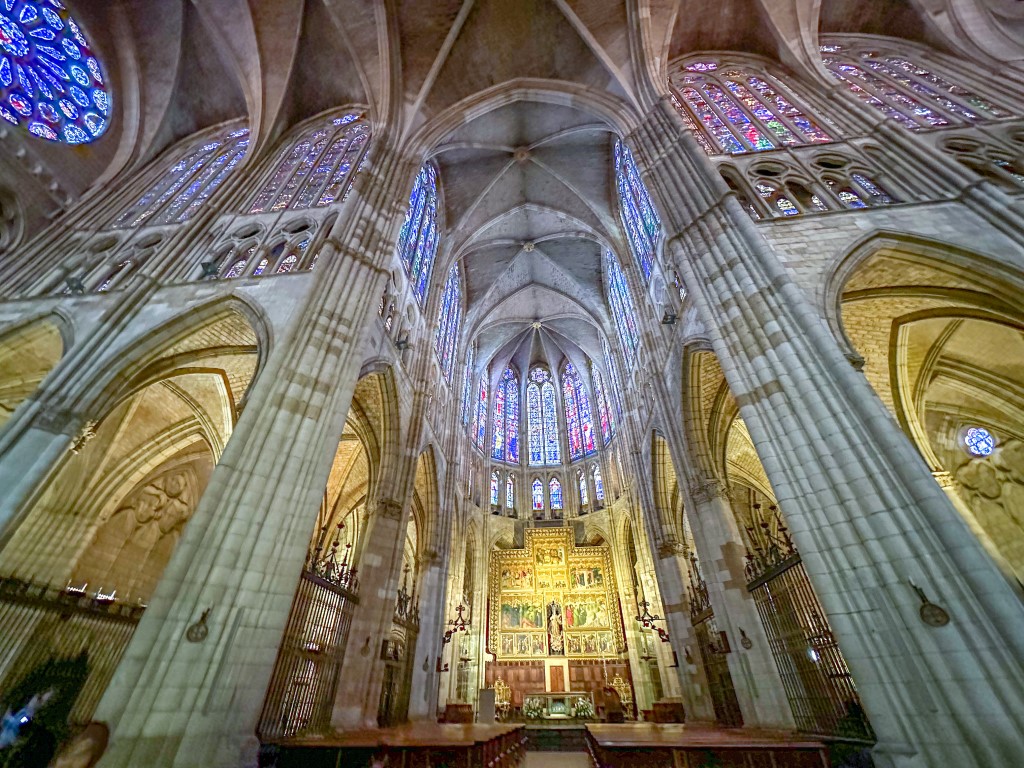León had popped up on my radar when I read a trip report that mentioned the León Cathedral and once I googled a few images it became a definite in the itinerary.
Having booked our accommodation just out of the pedestrianised old town we were only a short walk from the Cathedral, it was the first place we visited and it was amazing.
Santa María de Regla de León Cathedral is a Catholic church dedicated to the Virgin Mary and was commenced in the 13th century and became the first monument declared by the Royal Order of Spain in 1844.
It was built in the Gothic style with French influences but is particularly famous for its 1,800 square metres of stunning stained glass windows which architecturally was quite rare in medieval Gothic times.
The facade is made up of two towers with the central portion dominated by a beautiful rose window.






The Cathedral was quite busy as apart from being arguably the best example of the Gothic style in Spain, it is also a key stop on the Pilgrim’s walk to Santiago de Compostela.
After a considerable length of time we ventured outside and wandered around the Museum, the cloisters and the Roman baths that the cathedral is built upon. All in all absolutely worth our short diversion to León and we weren’t done yet!

Russell’s bad knee wasn’t feeling up to any more walking so Fiona and I set off to find the Museum of Contemporary Art (MUSAC), another achitectural delight we were told. It WAS quite a walk but there was no mistaking it when it came into view.
The glass mosaic of 37 colours that receives the visitor on the main facade was taken from digital processing of an image from the stained-glass window called “The Falconer” in the Cathedral of Leon. The window is one of the oldest (13th c.) and depicts scenes from a hunt.

We didn’t really have the energy to visit inside so we took our photos and walked back to the apartment for a cold drink along the way, noting several cool references to the city’s namesake 😉



León again presented challenges for the vegetarian amongst us 😉 but we ended up finding a wonderful Indian takeaway that surpassed all expectations and we had a quiet night in, people watching from our window.
The following day, our last here, we headed off to see the next thing on the checklist, the Convento de San Marcos, formerly a convent as the name suggests but now a luxury hotel.
I would love to have stayed here but the rate was way above even my budget so we contented ourselves with a quick peak into the foyer before we explored the parts that are open, namely a museum and a consecrated church.
The origins of this building lie in the twelfth century, in the days of Alfonso VII of León. His sister, the Infanta Sancha of Castile, made a donation in July 1152 to construct a modest building on the outskirts of the walled city, on the banks of the Bernesga river, where “the poor of Christ” could stay.
The darkest period in the monastery of San Marcos’s five centuries of history is concentrated in just four years. During the course of the Spanish Civil War cells, rooms, stables, cloisters, church, choir, museum and every fast corner of the building were transformed into impromptu dungeons or jailers’ offices, in what became officially known as “Campo de concentración de San Marcos” (San Marcos concentration camp). Between July 1936 and the end of 1940, up to 7,000 men and 300 women were imprisoned at the same time. It is estimated that, over the entire war and the period immediately following, the number of Republican militia members and political prisoners that passed through its cells totaled some 20,000. (thanks Wikipedia)



These four years of history are hard to imagine as you wander through such a beautiful and serene building.
The last building I had wanted to see was Casa Botines, famous because it is one of the few buildings designed by Antoni Gaudi but built outside of Barcelona. It was initially built for a fabrics company but now houses a museum dedicated to Gaudi, Spanish art of the 19th and 20th centuries, and the history of the building itself. Unfortunately it was partly covered in scaffolding today. In retrospect we should have visited at least the Gaudi museum but I think we were a bit museum’d out by then..
Goodbye León you were well worth the detour, tomorrow we’re heading north to the Asturian coast, lets hope the sunshine continues. 😎




